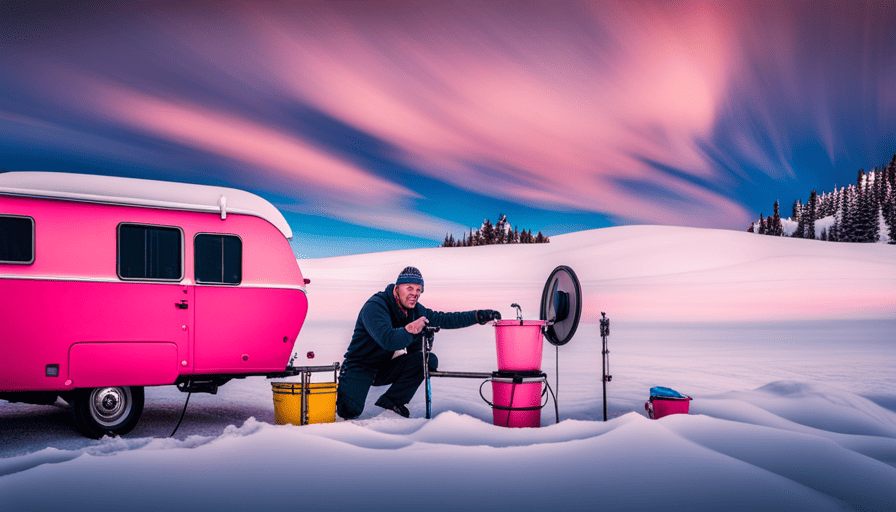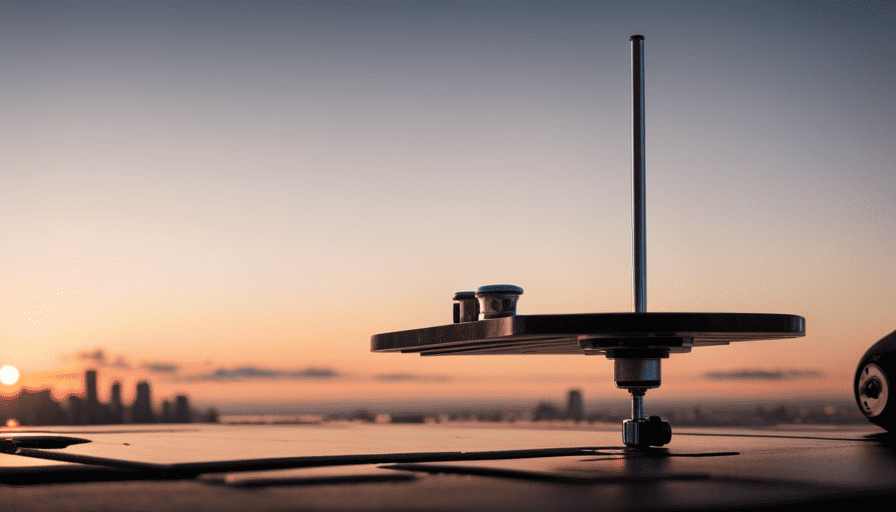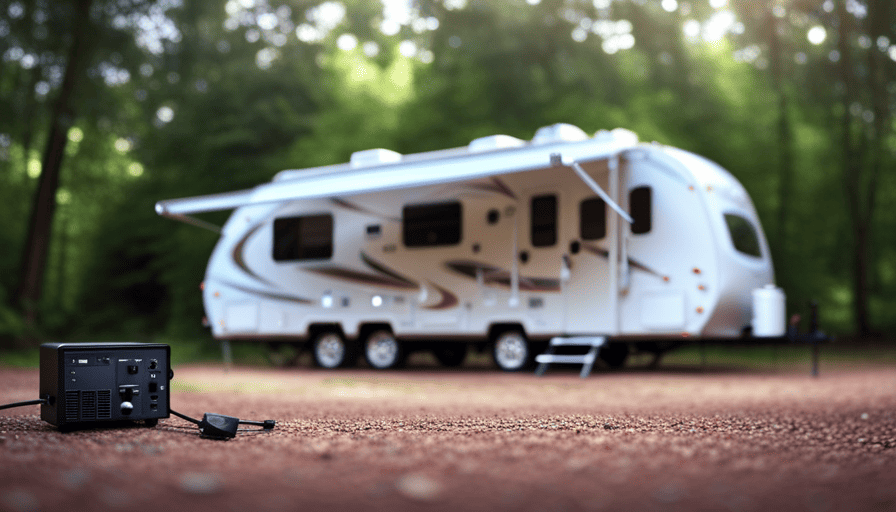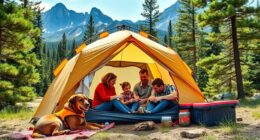Hello, fellow explorers! Once again, we’ve reached the momentous occasion where we say goodbye to the frigid winter days and greet the inviting warmth of spring. Is there a more perfect way to celebrate this seasonal transition than by preparing your cherished camper trailer for the warmer months ahead? Believe me, it feels as though you’re pampering your rolling home with a rejuvenating spa day after its lengthy slumber.
In this informative and detailed guide, I’ll walk you through the step-by-step process of de-winterizing your camper trailer. From removing those winter covers to checking the tires, brakes, and lights, we’ll make sure your trusty companion is ready to hit the road with full force.
We’ll even dive into the nitty-gritty of flushing and sanitizing the freshwater system, testing the electrical system, and inspecting every nook and cranny of the interior.
So grab your coffee, put on your handyman hat, and get ready to bring your camper trailer back to life.
Let’s embark on this adventure together, shall we?
Key Takeaways
- Remove winter covers or tarps from exterior
- Inspect and clean exterior, including roof, windows, and siding
- Check tire pressure, tread wear, and rotate tires regularly
- Flush and sanitize freshwater system and check for leaks
Remove any winter covers or tarps from the exterior of the camper trailer.
Now it’s time to peel off those winter covers or tarps that have been hugging your camper trailer all season long. As the weather warms up and camping season approaches, it’s important to prepare your camper for the adventures ahead.
Removing the winter covers or tarps is the first step in this process. Preparation tips for removing the covers or tarps include making sure you have a clean and dry area to work in. Sweep away any debris or dirt that may have accumulated on top of the cover. This will prevent any unwanted materials from falling into the camper when you remove the cover.
Once you have a clean work area, carefully remove the cover or tarp from the camper. Start at one corner and slowly peel it away, being cautious not to damage any part of the trailer. It’s important to take your time and be gentle during this process to avoid any tears or rips.
Maintenance recommendations for the cover or tarp include inspecting it for any signs of wear or damage. If you notice any tears or weak spots, it may be necessary to repair or replace the cover before storing it for the season.
With the covers or tarps removed, it’s time to inspect and clean the exterior of the trailer, including the roof, windows, and siding.
Inspect and clean the exterior of the trailer, including the roof, windows, and siding.
First, take a moment to appreciate the beauty of your outdoor oasis as you inspect and give a thorough cleaning to the exterior, from the roof to the windows and siding.
To properly de-winterize your camper trailer, it’s essential to inspect and clean the exterior to ensure its longevity and functionality.
When it comes to cleaning products for camper trailers, it’s important to choose ones that are specifically designed for RV use. Look for mild, non-abrasive cleaners that are safe for different surfaces such as fiberglass, aluminum, or vinyl siding.
Additionally, consider using a long-handled brush or a pressure washer to reach high areas like the roof. This’ll help remove any dirt, debris, or mold that might have accumulated during the winter months.
Maintaining the exterior of your camper trailer is crucial for its overall condition. Regularly inspecting for any signs of damage, such as cracks or leaks, can prevent larger issues down the road. Pay extra attention to the seals around windows and doors, as they can deteriorate over time and cause water damage.
Inspecting and cleaning the exterior of your camper trailer is an important step in the de-winterization process. By using the proper cleaning products and maintaining the exterior, you can ensure the longevity and functionality of your outdoor oasis.
Next, let’s move on to checking the tires for proper inflation and tread wear.
Check the tires for proper inflation and tread wear.
Don’t forget to take a moment to marvel at the stunning condition of your outdoor oasis as you check the tires for proper inflation and tread wear on your camper trailer. Tire maintenance is crucial for the safety and performance of your trailer, so it’s essential to give them a thorough inspection before hitting the road.
Here are some key steps to follow:
-
Check tire pressure: Use a tire pressure gauge to ensure that each tire is inflated to the manufacturer’s recommended level. Improper tire pressure can lead to uneven wear and poor handling, so it’s important to maintain the correct pressure.
-
Inspect tread wear: Examine the tread depth and look for any signs of uneven wear or damage. Uneven wear may indicate alignment or suspension issues that need to be addressed.
-
Look for cracks or bulges: Inspect the sidewalls of the tires for any cracks or bulges, as these can be indicators of potential tire failure.
-
Rotate the tires: Regularly rotating your tires helps ensure even wear and extends their lifespan.
-
Consider tire pressure monitoring system: Investing in a tire pressure monitoring system can provide real-time updates on tire pressure and temperature, giving you peace of mind while on the road.
Now that you’ve checked the tires, it’s time to move on to the next important task: testing the brakes and lights to ensure they’re functioning correctly.
Test the brakes and lights to ensure they are functioning correctly.
Make sure you test your brakes and lights to ensure they’re working properly before hitting the road. Brakes and lights maintenance is crucial for the safety of both you and other drivers on the road. Start by checking the brake fluid level and make sure it’s within the recommended range. If the fluid is low, add more to bring it to the correct level.
Inspect the brake pads and rotors for any signs of wear or damage. If you notice any issues, such as uneven wear or a squeaking noise when applying the brakes, it may be necessary to replace the pads or rotors.
Next, check all the lights on your camper trailer, including the headlights, taillights, brake lights, and turn signals. Ensure that all the bulbs are functioning correctly and replace any that are burnt out. Troubleshooting brake and light issues can sometimes be tricky, so it may be helpful to have a friend or family member assist you.
Once you have tested and addressed any brake or light issues, you can transition into the next step of de-winterizing your camper trailer. It’s time to flush and sanitize the freshwater system, including the tanks and pipes.
Flush and sanitize the freshwater system, including the tanks and pipes.
To ensure a clean and safe water supply, it’s crucial to flush and sanitize the freshwater system, including the tanks and pipes. Freshwater system maintenance is an important step in de-winterizing a camper trailer. Proper tank cleaning techniques are necessary to remove any debris or bacteria that may have accumulated during the winter months.
To start, I recommend draining any remaining water from the tanks and pipes. This can be done by opening the drain valves and allowing the water to flow out. Once the tanks are empty, close the valves and proceed to the next step.
Next, fill the freshwater tanks with a mixture of water and a sanitizing solution. This solution can be made by mixing 1/4 cup of bleach with 1 gallon of water. It’s important to use a non-scented bleach to avoid any unwanted odors in the water system.
After filling the tanks, turn on the water pump and open all the faucets inside the camper. This will allow the sanitizing solution to flow through the pipes and faucets, ensuring all areas are properly cleaned. Let the solution sit in the system for at least 12 hours to effectively kill any bacteria or contaminants.
Once the sanitizing time is up, drain the tanks and pipes again, making sure to flush out any remaining solution. Refill the tanks with fresh water and run the faucets until the water runs clear, indicating that all traces of bleach have been removed.
Incorporating a 3 column and 3 row table, here is a summary of the steps for flushing and sanitizing the freshwater system:
| Step | Procedure |
|---|---|
| 1 | Drain remaining water from tanks and pipes |
| 2 | Fill tanks with a mixture of water and sanitizing solution |
| 3 | Turn on water pump and open all faucets to allow solution to flow |
| 4 | Let solution sit in system for at least 12 hours |
| 5 | Drain tanks and pipes again, flush out remaining solution |
| 6 | Refill tanks with fresh water and run faucets until water runs clear |
With the freshwater system properly flushed and sanitized, it’s time to move on to the next step: check and clean the propane system, ensuring all connections are secure.
Check and clean the propane system, ensuring all connections are secure.
Now that you’ve ensured a clean and safe water supply, it’s time to check and clean the propane system in your camper, making sure all connections are secure. Propane safety is of utmost importance when it comes to enjoying a worry-free camping experience. Here are a few steps to help you maintain a safe and efficient propane system:
-
Inspect the propane tanks: Start by visually inspecting the propane tanks for any signs of damage or rust. Ensure that the tanks are properly secured and the valves are tightly closed.
-
Check for leaks: Use a propane leak detector or a soapy water solution to check for any leaks in the propane system. Apply the solution to all connections, fittings, and valves. If you notice any bubbles forming, it indicates a leak, and immediate action should be taken.
-
Clean the propane appliances: Remove any dust, debris, or spider webs from the propane appliances. Use a soft brush or cloth to clean the burners, vents, and any other parts that may have accumulated dirt.
Maintaining a secure and efficient propane system is crucial for a safe camping trip. With these steps, you can ensure propane safety and enjoy your camper to the fullest.
Now, let’s move on to the next section where we’ll test the electrical system, including the battery and charging system.
Test the electrical system, including the battery and charging system.
First things first, it’s time to ensure your camping experience is electrifying by testing the battery and charging system in your camper.
Battery maintenance is crucial to keep your electrical system working efficiently. Start by inspecting the battery for any signs of damage or corrosion. Clean the terminals with a wire brush and apply a thin layer of petroleum jelly to prevent future corrosion.
Next, check the battery’s voltage using a multimeter. A fully charged battery should read around 12.6 volts. If it’s significantly lower, you may need to charge or replace the battery.
To troubleshoot electrical issues, start by checking the fuses and circuit breakers. Replace any blown fuses and reset any tripped breakers. Inspect the wiring for any signs of damage, such as frayed or exposed wires. If you notice any issues, it’s best to consult a professional for repairs.
Once you’ve tested and ensured the functionality of your battery and charging system, it’s time to move on to the next step: inspecting and cleaning the interior of the trailer, including the kitchen, bathroom, and sleeping areas.
Inspect and clean the interior of the trailer, including the kitchen, bathroom, and sleeping areas.
Once you step inside, the interior of your cozy home on wheels opens up like a flower in full bloom, inviting you to explore the kitchen, bathroom, and sleeping areas.
Organizing small spaces in a camper trailer can be a challenge, but with a few tips, you can make the most of the available space. Utilize storage bins and baskets to keep items neatly organized and easily accessible. Use vertical space by installing hooks or shelves on walls to hang utensils, towels, and other small items. Additionally, maximize storage under beds and benches by using vacuum-sealed bags for clothing and bedding.
Cleaning and maintaining the upholstery in a camper trailer is essential to keep it looking fresh and extend its lifespan. Start by vacuuming all surfaces to remove any dirt or debris. Treat stains promptly with a fabric cleaner suitable for your upholstery type. Regularly wipe down surfaces with a mild cleaner and a soft cloth to prevent dirt buildup. It’s also a good idea to periodically use a fabric protector spray to repel stains and spills.
As you wrap up your cleaning and organizing tasks, it’s time to check all appliances, such as the refrigerator, stove, and furnace, to ensure they’re in working order.
Check all appliances, such as the refrigerator, stove, and furnace, to ensure they are in working order.
To ensure a smooth and stress-free journey, you’ll want to thoroughly check all the appliances in your cozy home on wheels, including the refrigerator, stove, and furnace, making sure they are in perfect working order. Appliance maintenance is crucial for a hassle-free camping experience. Start by inspecting the refrigerator. Ensure it is clean and free of any mold or mildew. Check that it is cooling properly and that the door seals are intact. Next, examine the stove. Test each burner to make sure they ignite and adjust the flame as needed. Clean any grease or debris from the burners and check the propane supply. Lastly, inspect the furnace. Turn it on and listen for any unusual noises or smells. Check the air filters and ensure they are clean. Additionally, it is important to follow safety precautions when dealing with gas appliances. Check for gas leaks using a solution of soapy water and inspect the gas lines for any damage. Remember to turn off the gas supply when not in use. By taking these steps, you can rest assured that your appliances are in good working condition and ready for your next adventure. Now, let’s move on to the next section about packing and organizing your belongings, making sure to stock up on any necessary supplies for your trip.
Pack and organize your belongings, making sure to stock up on any necessary supplies for your trip
Don’t forget to pack and organize your belongings, making sure to stock up on any necessary supplies for your trip, so you can envision a well-prepared and enjoyable adventure in your cozy rolling home.
When it comes to packing for a camper trailer trip, there are a few tips that can help maximize your space and ensure you have everything you need.
First, it’s important to make a checklist of all the essential items you’ll need for your trip. This includes things like bedding, cooking utensils, toiletries, and any specific items you may need for your activities, such as hiking gear or fishing equipment. Make sure to pack these items in a way that maximizes space, using storage bins or vacuum-sealed bags if necessary.
Meal planning is another important aspect of organizing your camper trailer. Before your trip, sit down and plan out your meals for each day. This will not only ensure that you have all the ingredients you need, but it will also help you make the most of your limited kitchen space. Consider prepping some meals in advance, such as marinating meats or chopping vegetables, to save time and effort while on the road.
By following these packing tips and meal planning strategies, you can ensure that your camper trailer is well-stocked and organized for your trip. So, get ready to hit the road and enjoy a well-prepared and enjoyable adventure in your cozy rolling home.
Frequently Asked Questions
How often should I clean the exterior of my camper trailer?
Cleaning the exterior of your camper trailer is an essential part of its maintenance. It not only keeps your trailer looking shiny and new, but it also helps prevent damage from dirt, grime, and UV rays. The frequency of cleaning will depend on various factors such as weather conditions, usage, and storage location. Generally, it’s recommended to clean the exterior at least once every three months to ensure optimal cleanliness and protection.
What is the recommended method to sanitize the freshwater system?
To sanitize the freshwater system of your camper trailer, it’s recommended to use a mixture of bleach and water. Add 1/4 cup of bleach for every 15 gallons of water in the tank.
Fill the tank with this solution and run it through all faucets until you smell bleach. Let it sit for a few hours, then drain and flush the system with clean water.
Common mistakes to avoid include using too much bleach and not properly rinsing the system afterwards.
Are there any specific safety precautions I should take when checking the propane system?
When it comes to propane system maintenance and troubleshooting, there are some important safety precautions to keep in mind.
First, always make sure to turn off the propane supply before inspecting or working on the system.
Check for any leaks by using a soapy water solution on all connections and valves. If you detect a leak, don’t attempt to fix it yourself; instead, contact a certified technician.
Additionally, be cautious when handling propane tanks and follow proper storage and transportation guidelines.
How can I test the electrical system in my camper trailer?
Testing the electrical system in a camper trailer is crucial for a safe and functional experience. One interesting statistic to consider is that 60% of electrical issues in campers are caused by faulty wiring.
To test the system, use a multimeter to check voltage levels at the battery and each circuit. Troubleshooting techniques include inspecting fuses, checking for loose connections, and testing appliances individually. This will help identify any issues and ensure a smooth camping trip.
What are some essential supplies that I should stock up on before my trip?
Before your trip, it’s important to stock up on essential camping gear to ensure a smooth and organized experience.
Some must-have supplies include a tent, sleeping bags, camping chairs, cooking equipment, and a first aid kit.
To keep your camper trailer organized, invest in storage containers, hanging organizers, and collapsible bins.
Utilize hooks and racks to hang items and maximize space.
These tips will help you make the most of your camping adventure.
Are the Steps to De-Winterize a Fifth Wheel Camper and a Camper Trailer the Same?
The process of de-winterizing a fifth wheel camper and a camper trailer is generally similar. However, there may be some differences in specific steps due to variations in design. It is important to consult the manufacturer’s guidelines to ensure you follow the correct procedure for de-winterizing a fifth wheel camper and avoid any potential damage or issues.
Conclusion
In conclusion, de-winterizing a camper trailer is a crucial step in preparing for your next adventure on the open road. By following the steps outlined in this article, you can ensure that your trailer is in optimal condition and ready for your travels. Furthermore, it’s important to remember that how to winterize a camper properly will greatly impact how well your trailer holds up during the off-season. Taking the time to de-winterize your camper and properly prepare it for use will not only help prevent potential damage but also ensure a smoother and more enjoyable experience once you hit the road. So, whether it’s flushing the water system, checking the electrical connections, or inspecting the exterior for any signs of wear and tear, following the right steps for de-winterizing your camper is essential for a successful journey.
From inspecting the exterior to checking the appliances and stocking up on supplies, every aspect of the de-winterization process is important. Just like a skilled painter carefully brushes strokes of color onto a canvas, you too can bring life back to your camper trailer and embark on unforgettable journeys.










